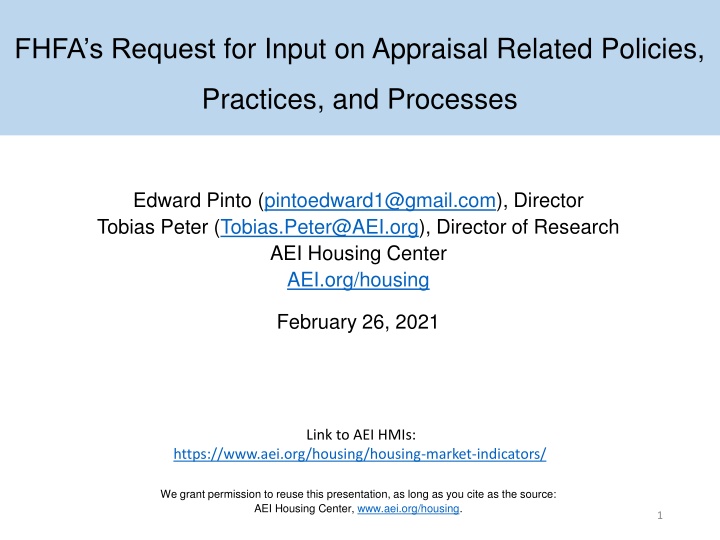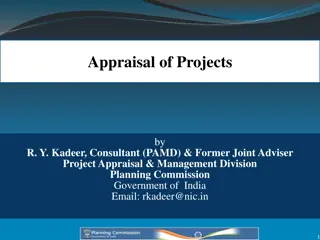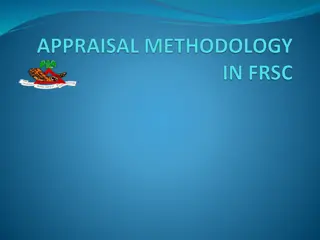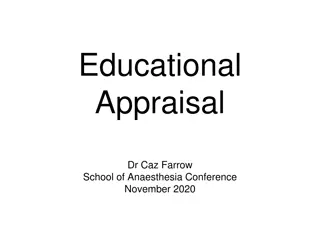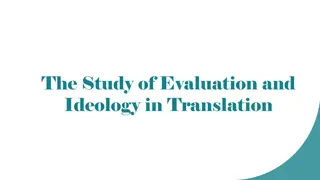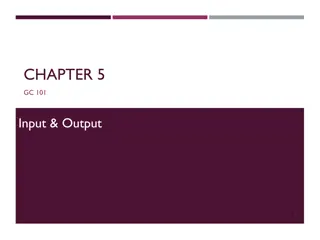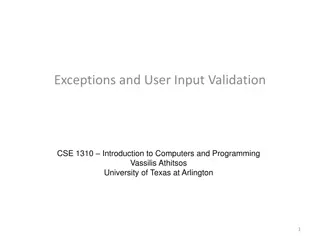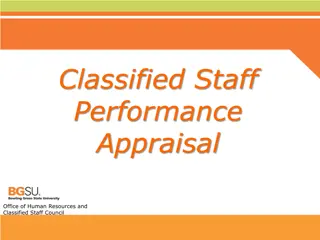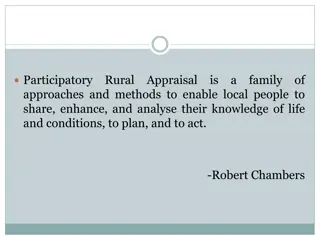FHFAs Request for Input on Appraisal Related Policies
alleged racial bias in appraisals for mortgage loans with insights from recent reports and studies. Learn about valuation gaps, systemic bias, and the need for evidence-based policy responses.
Download Presentation

Please find below an Image/Link to download the presentation.
The content on the website is provided AS IS for your information and personal use only. It may not be sold, licensed, or shared on other websites without obtaining consent from the author.If you encounter any issues during the download, it is possible that the publisher has removed the file from their server.
You are allowed to download the files provided on this website for personal or commercial use, subject to the condition that they are used lawfully. All files are the property of their respective owners.
The content on the website is provided AS IS for your information and personal use only. It may not be sold, licensed, or shared on other websites without obtaining consent from the author.
E N D
Presentation Transcript
FHFAs Request for Input on Appraisal Related Policies, Practices, and Processes Edward Pinto (pintoedward1@gmail.com), Director Tobias Peter (Tobias.Peter@AEI.org), Director of Research AEI Housing Center AEI.org/housing February 26, 2021 Link to AEI HMIs: https://www.aei.org/housing/housing-market-indicators/ We grant permission to reuse this presentation, as long as you cite as the source: AEI Housing Center, www.aei.org/housing. 1
AEIs In-depth Study into Alleged Racial Bias by Appraisers on Mortgage Loans Full report may also be found at: https://www.aei.org/economics/special-briefing-on-appraiser-bias/ 2
How Common Is Appraiser Racial Bias? An Analysis Using Big Data to Inform as to Whether It Is Common or Uncommon that an Appraiser s Knowledge of an Applicant s Race Results in Valuation Bias Edward Pinto (pintoedward1@gmail.com), Director Tobias Peter (Tobias.Peter@AEI.org), Director of Research AEI Housing Center Working Report AEI.org/housing January 19, 2021 Link to AEI HMIs: https://www.aei.org/housing/housing-market-indicators/ We grant permission to reuse this presentation, as long as you cite as the source: AEI Housing Center, www.aei.org/housing. 3
Recent Reports Alleging Racial Bias by Appraisers on Mortgage Loans New York Times examples* $135,000 or 29% difference (Jacksonville FL - appraisal 1: $330,000, appraisal 2: $465,000) $40,000 (% unknown) difference (Hartford, CT suburb) $160,000 or 24% difference (Los Angeles - appraisal 1: $500,000, appraisal 2: $660,000) Denver News Channel 7 example** $145,000 or 26% (Denver, CO appraisal 1: $405,000, appraisal 2: $550,000) Chicago Sun Times example*** $62,000 or (Chicago, IL appraisal 1: $278,000, appraisal 2: $340,000) Of four examples with sufficient data, appraisal 1 came in an average of about $126,000 or 25% lower than appraisal 2. Claims of bias were based on an allegation that a human appraiser was aware of the applicant(s) race either from a meeting or photos or other items in the home which indicated race, and as a result, the appraiser underestimated the property s value. Allegations commonly occurred in predominantly White neighborhoods. The implication is that intentional and perhaps unintentional appraisal bias is commonplace and the valuation gaps are large. While the facts alleged may well be true, any policy response must be based on whether the cases are the result of bad apple appraisers or systemic racial bias. A literature search found no statistical analysis of this type of claim. Using big data we conduct the first analysis into whether the alleged practices of intentional racial bias, along with unintentional bias, are common or uncommon. * https://www.nytimes.com/2020/08/25/realestate/blacks-minorities-appraisals-discrimination.html ** https://www.thedenverchannel.com/news/local-news/an-unconscious-bias-biracial-denver-couple-says-they-faced-discrimination-on-home-appraisal *** https://chicago.suntimes.com/2020/10/7/21493755/chicago-home-appraisal-black-race-homeowners 4
We Asked the Collateral Risk Network (CRN) to Survey Appraisal Management Companies and Lenders Why: our data consist of appraisals on transactions that actually closed, thus we need to evaluate whether our set suffers from selection bias as discrimination might occur with respect to appraisals not used in loan closings. The question is: how likely is that Review of Valuation (ROV) requests are received and what happens after an ROV is made? Here are relevant results: AMC Frequency of Review of Valuation (ROV) requests: AMCs generally do not see ROV requests) 1. Poor selection of comps 2. Recent Improvements not noted 3. Sq. Ft. incorrect Regarding ROVs involving racial or ethnic bias: <10% 42% Never 0 (0%) <10% 17 (89%) 10-30% 2 (11%) >30% 0 (0%) Never 3 (17%) <10% 9 (50%) 10-30% 5 (28%) >30-60% 0 (0%) >60% 1 (6%) Are ROVs more common on refinance or purchases? Lenders 1st survey- 2.5% (median for 12 responses) 2nd survey- 3% (median for 8 responses) 1. Poor selection of comps 2. Sq. Ft. incorrect 3. Recent Improvements not noted 63% 37% 2 (25%) 4 (50%) 2 (25%) 0 (0%) 0 (%) 5 (71%) 1 (14%) 1 (14%) 0 (0%) Insufficient data (only 1 response, as Most common reasons for a ROV (where one is given): Never 58% When you do get an ROV, how many get escalated to a second appraisal? How many contracts get renegotiated? 68% refi 63% refi Conclusions: Items noted in red are not unique to claims of racial or ethnic bias, but are common to all ROVs. An ROV is rare (2.5%-3% incidence), ROVs are related to race or ethnic bias are also rare, and an ROV is a condition precedent to a second appraisal, which itself is relatively rare (about 10%-20% incidence). Based on the survey, we may conclude that our data set, consisting entirely of closed loans, does not suffer from a significant level of selection bias. 5
Home Mortgage Disclosure Act Data for 2018-2019 (HMDA) and HUD Data for 2019-2020 Seemingly Confirm That Selection Bias Is Low HMDA, a virtual census of institutional loan app data, covered >8 million applicants. White Black Total Applications % of Application Denied % Denial Reason is Collateral % Denial Reason is DTI or Credit History Total Applications % of Application Denied % Denial Reason is Collateral % Denial Reason is DTI or Credit History Note: Data for 1st lien, 1-unit, owner-occupied homes only. Excludes I/O, balloons, or neg. am. loans. Denial for principal denial reason only. Source: HMDA 2018 & 2019 4,995,603 614,394 26% 14% 54% 782,255 17% 16% 17% 49% Refi 6,065,075 8% 13% 56% Purchase 8% 66% HUD data: There is no national appraisal discrimination complaint database. Given HUD s fair housing role, it does receive appraisal bias complaints. In 2019 and 2020 there were 3 and 6 respectively. Conclusions: HMDA loan denial rate on refis is 16% for White applicants and 26% for Black applicants; denial rate on purchase loans is lower for both White and Black applicants. The main reasons for Black denials are credit history and DTI. Collateral is noted as a denial reason less for Black applicants than White ones and perceived or alleged bias would be one of a number of potential reasons for a collateral denial. Based on HMDA data, the potential for bias by an appraiser is small, since it would be a percentage of a percentage of a percentage. Since HMDA is consistent with the results of the CRN survey and since HUD receives relatively few complaints, notwithstanding media coverage of appraiser bias, we may conclude that our data set, consisting entirely of closed loans, does not suffer from a significant level of selection bias. * https://www.washingtonpost.com/realestate/for-black-homeowners-a-common-conundrum-with-appraisals/2021/01/20/80fbfb50-543c-11eb-a817- e5e7f8a406d6_story.html 6
Analytical Framework Refi Human appraisal GSE appraisal waiver based on evaluating value set forth in application (They are unbiased as race is not taken into account) CRN survey suggests this is infrequent Alleged biased 1st appraisal based on appraiser having knowledge of applicant s race. Media allegations generally occurred in White neighborhoods. Unbiased 1st appraisal Outcomes in blue are what we observe in the data and what are used for the analysis. We don t know the frequency CRN survey suggests this is infrequent The more biased appraisals there are and the larger the bias, the easier it will be to detect them in the results and vice versa. Consumer does not request ROV but proceeds with an alleged biased 1st appraisal Consumer accepts 1st appraisal and loan does not get made Requests ROV for racial bias Consumer proceeds with an alleged biased 1st appraisal Consumer accepts 1st appraisal and loan does not get made Yields a presumably unbiased 2nd appraisal CRN survey suggests this is infrequent We don t know the frequency CRN survey suggests this is infrequent 7
We Use Big Data to Evaluate the Likelihood of Racial Bias by an Appraiser The AEI Housing Center has assembled the National Housing Market Database (NHMDB), which uses and connects many different datasets. Most in-depth resource for key housing data and trends. Accurate, timely, and in-depth coverage of purchase trends. Connects the dots for many housing indicators, yielding the most comprehensive analysis of the housing market. Its integrated structure is uniquely suited to study countless questions. Here we apply the NHMDB to help shed light on the question: Is there intentional or unintentional racial bias by appraisers? We are able to identify whether the transaction had a human appraiser or a GSE appraisal waiver using a computer generated value. The waiver value is unbiased, as neither race nor any other borrower characteristic is used that could be correlated with race is used in generating the value. We use the race neutral Automated Valuation Model (AVM), where neither race nor any other borrower characteristic is used that could be correlated with race is used in generating the value. The AVM controls for non-racial factors that affect home value, leaving the race dummies to pick up any racial effects. AVMs allow us to statistically test bias assertions by objectively assessing previously performed human appraisals and appraisal waivers. A literature search found no statistical analysis of this type. This study is based on 243,000 appraisals (of which 59,000 are GSE appraisal waiver cases & 22,000 GSE human appraisals), & 2,600 group match cases originated in 2018 & 2019. Unintentional bias may have a disparate impact, but it must be demonstrated that a challenged practice involving racial bias is the substantial cause of the disparate impact. Using computer generated property values, we used big data to look for bias of the type alleged in the media and racial bias that might result in a disparate impact allegation. This Working Report presents preliminary results and we welcome comments. 8
Using Big Data to Evaluate the Presence of Appraiser Bias NHMDB data used in performing this analysis include: Public records Automated Valuation Models (AVM) National Mortgage Risk Index using agency loan data, including use of appraisal waivers Home Mortgage Disclosure Act (HMDA) data Our main focus is on refinance loans: Refinance loans lack an arm s length transaction, potentially providing more of an opportunity to exercise racial bias. Purchase loan appraisals are highly anchored to the sales price and therefore tend to not come in below the sales price.* This makes them useful as a check, since they provide less of an opportunity and potential to exercise racial bias. Thus, deviations due to bias, if present, should be larger for unanchored refi valuations compared to anchored purchase valuations. FHA purchase loans have a unique double anchor, which is useful for a natural experiment: The 1st anchor is to sales price and the 2nd to a statutory maximum LTV of 96.5%. Also, an average LTV of around 95% for groups being compared, which means even a small gap between the sales price and appraised value would require a price renegotiation with the seller. * Contract Price Confirmation Bias: Evidence from Repeat Appraisals 9
Methodology We use 2 different approaches, to see if on average there is a value difference (or a gap) between refinance loan appraisals for Blacks and Whites, in order to evaluate the existence of bias, especially as it relates to the alleged practices. Automated Valuation Model (AVM) approach (N-count = 243,000 loans) We regress the log Dec-2017 AVM, month of origination dummies, census tract fixed effects, and a dummy variable for minority status on the log property value. An AVM provides a neutral control for neighborhood and home characteristics. Lacks knowledge of applicant s race. We filter out properties with extreme outliers in home characteristics. Our analysis is enhanced by running it separately for loans using human generated appraisals vs. waivers confirming the self-evaluation or arms-length transaction price through a computer generated model (the AVM noted above is independent of the self-evaluation value, the arms-length transaction price, and the waiver value). The goal is to determine whether an alleged practice (such as racial bias based on knowing whether an applicant is Black from a meeting or interior items (i.e. photos, art, or books) occurs more frequently on Black refi valuations by humans. A second goal is to test for unintentional racial bias against Blacks on refi valuations by humans that has a disparate impact and is the substantial cause of the disparate impact. Hedonic approach is used to check the AVM approach: We replace the AVM with house characteristics (sq. footage, lot size, year built, and census tract). Group approach (N-count = 2,600 groups): Identify groups of homes that are identical based on external characteristics (same census tract, home type, sq. footage, lot size, year built, # of baths, and land use code), within 1,650 ft of each other (median: 200 ft), and owned by households of different racial backgrounds. Rules out challenged practices such as comp selection, neighborhood effects, and AVM bias as an explanation. We regress a set of dummies for minority status and month of origination on the log property value. The group of homes are treated as fixed effects. We define the following non-overlapping groups (N-counts): AVM/Hedonic GSE Human 212,935 30,435 GSE Waiver 21,539 1,391 Group 3,563 2,810 White (defined as non-Hispanic White) Black (defined as non-Hispanic Black) 53,397 5,393 Note: 2% of Hispanics identify as Black Hispanic. These loans are excluded from this analysis. 10
Note on Interpreting the Results Purchase loans are arm s length transactions between consumers. Due to anchoring to the sale price, the opportunity for racial bias from appraisers is low to non-existent. The consumers establish the true price of the asset, including quantifying the impact on price of the current state of improvements, upkeep, or decoration (unobservable factors). A computer model can only approximate these items, as it is limited by data availability. We use a computer generated AVM as a control for home quality, thus unobservable factors will be present in both our purchase and refi analysis. Due to anchoring, purchase results can serve as benchmark on the magnitude of these unobservable factors. Results for both approaches found similar gaps for both refinance and purchase loans, thus we are able to attribute the refi loan gaps to unobservable factors rather than bias. Below we compare results for refi and purchase loans using the AVM approach. While there is a modest gap between Blacks and Whites for refis, a slightly larger gap exists for purchase loans. As noted, we compare refis to purchase loans to account for unobservable factors. It appears Blacks on average receive slightly higher appraisals than Whites. Gap between Blacks and Whites after accounting for unobservable factors 0.0 ppt. AVM Approach Gap between Blacks and Whites 1. For refinance loans only 2. For purchase loans only Note: The results are differences in property value relative to Whites. *** denotes significance at the 1% level. Data for this approach are limited to property value $100,000-$1,000,000, Year built between 2000-2019, Lot sizes of 2,000-20,000 sq. ft., and Building area of 800-3600 sq. ft. -0.7%*** -0.7%*** The Group approach, by its design, also provides a compelling means to determine whether racial bias exists. However, it also cannot fully eliminate all unobservable factors. Due to small n-sizes, we report these findings second. (By mid-2021 we expect to be able to add another year of data, growing our n-sizes. This will add to the utility of this approach.) Due to space concerns, the following slides do not explicitly report the gap between Blacks and Whites refinance loan appraisals after accounting for unobservable factors (red) leaving readers to do so on their own. 11
AVM Approach Results for Refinance Loans The media reports all had a common challenged practice: the human appraiser knew the applicant was Black by having met the applicant or from photos in the home and rendered a biased opinion of value that was below the property s correct value. The race neutral AVM approach was applied to valuations on: 1. refinance loans generally, 2. purchase loans, and 3. refinance loans with either a human appraisal or a waiver. #1 (refinance loans only) includes instances where biased refi valuations have been rendered. #2 (purchase loans only) would be much less influenced by bias due to anchoring to the sale price by human appraisers. #3. a. (waiver only) has lack of knowledge of race and interior condition, or the potential for bias in the selection of comps and should be free of racial bias due to the common practice noted above. Our results indicate that for #2 (purchase loans) and #3.a. (non-human valuations), Blacks had nearly identical valuation gaps as Whites (-0.8% and -0.5% respectively), as #1 (-0.7%). Thus we conclude allegation that knowing the race of the applicant results in racial bias by appraisers on refinance loans is uncommon and not systemic. This same analysis supports the conclusion that unintentional bias based on race is also uncommon and not systemic. AVM Approach 1. For refinance loans only 2. For purchase loans only 3. Limited to refinance loans with an Appraisal/Waiver Flag (GSE only) a. Waiver only b. Appraisal only Note: The results are differences in property value relative to Whites. *** denotes significance at the 1% level. Data for this approach are limited to property value $100,000-$1,000,000, Year built between 2000-2019, Lot sizes of 2,000-20,000 sq. ft., and Building area of 800-3600 sq. ft. Gap between Blacks and Whites -0.7%*** -0.7%*** -0.7%*** -0.3% -0.8%*** 12
AVM Approach: Robustness Checks Gap btw. Blacks and Whites -0.7%*** AVM Approach for refinance loans Check 1. AVM Approach for refinance loans but using quantile regression (median value) Check 2. AVM Approach for refinance loans but limiting to properties with values between the 20th and 80th percentile at the census tract level Check 3. AVM Approach for refinance loans but adding controls for FICO bucket, income, CLTV bucket, and the # of borrowers Check 4. Hedonic approach for refinance loans Check 5. Hedonic approach for purchase loans -0.7% -0.4%*** 0.4%** -2.3%*** -2.4%*** Note: The results are differences in property value relative to Whites. ** denotes significance at the 5% level and *** at the 1% level. Data for these approaches are limited to property value $100,000-$1,000,000, Year built between 2000-2019, Lot sizes of 2,000-20,000 sq. ft., and Building area of 800-3,600 sq. ft. Checks 1 &2 focus on the impact of outliers, as the anecdotal value gaps averaged 25% and indicate that the AVM Approach results are very robust (that is, remain valid under different assumptions, parameters and initial conditions). Check 3, which controls for certain borrower characteristics, eliminates the small gap between Blacks to Whites (now a small positive gap). Generally, higher income, higher FICO, lower CLTV, and 2 borrowers mean a slightly higher appraisal. The results are also generally robust for different states, but n-counts are often too small for a systematic analysis. Checks 1-3: the gaps for refinance loans likely reflect unobserved property or location characteristics that are not captured in the AVM. Checks 4 and 5 yields a Black-White gap of -2.3% on refinance and -2.4% on purchase loans. Racial discrimination is unlikely on purchase loans due to sale price anchoring. Checks 1-5 support our conclusion that the common challenged practice of knowing the race of the applicant results in racial bias by appraisers on refinance loans is uncommon and not systemic. They also support the conclusion that unintentional bias based on race is also uncommon and not systemic. More robustness checks are provided in the appendix. 13
Group Approach Results Group Approach 1. For refinance loans only 2. For purchase loans only Note: The results are differences in property value relative to Whites. The results are not statistically significant.Data for this Approach are limited to homes built between 1950 and 2019 and 1-unit SF, condos, townhomes, or PUDs within 500m of each other (median is 200 ft). Gap between Blacks and Whites -0.4% 0.0% This approach looks at two or more identical homes, so as to reduce the possibility for variation between the groups. This reduces the likelihood that variation in selected comparable sales, differences in racial make-up of comparable locations, & location within a neighborhood affect the result. The Group approach, by its design, provides the most compelling evidence regarding the existence of racial bias. The Group approach has results that are quite close to the AVM approach for refinance loans and there is only a small difference to purchase loans, for which biased appraisals are unlikely. It also supports our earlier conclusions that intentional and unintentional appraiser bias based on race is uncommon and not systemic. We ended up with around 2,600 home groups with owners of a different race. The results seem to hold for townhomes or condos only, but n-counts are fairly small. There is no statistically detectable difference between Waivers and Appraisals for identical homes, but n-counts again are fairly small. 14
Refi Waiver-Appraisal Gap between Whites (Control Group) and Blacks The Gap of a Human Appraisal Relative to a Waiver White (control group as presumably unbiased on race) Black Using AVM Approach to Measure Gap N-Count (Appraisal) N-Count (Waiver) -0.8%*** 45,155 19,987 -1.4% 4,422 1,271 Note: Borrower controls are FICO and LTV buckets, the number of borrowers, and income. *** denotes significance at the 1% level. Data are limited to property value $100,000-$1,000,000, Year built between 2000-2019, Lot sizes of 2,000-20,000 sq. ft., and Building area of 800-3,600 sq. ft. They are also limited to GSE borrowers with CLTVs <= 80% since waivers have an eligibility criterion. Here we examine the gap within the each group between the refi human appraisal and the Waiver. Whites with a human appraisal get 0.8% lower value than Whites with a refi waiver and this result is highly statistically significant (at 1% level). Whites serve as the control group because their appraisals should not be biased and the Waiver is in theory color blind. Blacks with a refi human appraisal get 1.4% lower value than Blacks with a refi waiver appraiser. However, this result is not statistically significant at the 5% level, with a confidence range of +0.3% to -3.2%. The difference between the White and Black groups is 0.6%, basically the same as for the AVM and the Group approaches. This result further supports our conclusion that intentional and unintentional racial bias by appraisers on refinance loans is uncommon and not systemic. 15
FHA Purchase Transactions: A Unique Natural Experiment to Evaluate Bias FHA purchase appraisals are helpful as a check because they are prone to anchoring in two ways: Sales price as usual. Also prone to LTV anchoring due to the statutory LTV limit of 96.5%. There is another helpful characteristic: an average LTV of 95.23%, only slightly below the statutory maximum 96.5%. As the chart below demonstrates: FHA purchase loan median LTV equals 96.5% for all listed groups. Since 73% of FHA loans are at the cap, the median LTV equals the cap. FHA purchase loan mean LTVs are all in a tight range relative to median LTVs (White and Black applicants have a 0.48% mean LTV difference). LTV of FHA Purchase Loans # of obs. Median Mean White 375,508 96.50 95.04 Black 92,985 96.50 95.52 Note: Data cover an estimated 99% of the agency market. Source: AEI Housing Center National Mortgage Risk Index. 16
FHA Purchase Transactions: a Natural Experiment to Evaluate Bias (Contd) Gap btw. Blacks and Whites # of observations AVM Approach (all loan types) FHA only AVM Approach (all loan types) FHA only -0.7%*** 1.0%*** -0.7%*** -0.3% 299,930 35,070 243,370 30,992 Purchase Refi Note: The results are differences in property value relative to Whites. *** denotes significance at the 1% level. Data for this Approach are limited to property value $100,000-$1,000,000, Year built between 2000-2019, Lot sizes of 2,000-20,000 sq. ft., and Building area of 800- 3600 sq. ft. The results for FHA purchase loan appraisals, which involve substantial numbers of Black applicants, provide additional support for the existence of small appraisal valuation gaps, which cannot be attributed to racial bias (the positive gap for FHA purchase loans to Blacks may be due to the larger seller concessions allowed under the FHA program compared to conventional loans and which tend to be used more in low-income areas. Such concessions are absent on refis). As noted earlier, there is minimal to no difference between White and Black LTV levels. There are two outcomes that would result from bias, both of which are unlikely to occur. A biased lower valuation for Blacks, which if present in practice, would result in the frequent renegotiation of purchase contracts to a lower price, since the value does not support the loan amount and there is little LTV room. However, this would work to the benefit of the home buyer; and the CRN survey indicates renegotiations are infrequent. To display a bias, the appraiser abandons the tendency to anchor to both the purchase price and a key LTV level, yet the dollar difference here is so small that it itself would be red flag and would create a notable headache for the appraiser over the small amount. The results for refinance loans are fairly similar to purchase loans, and as noted above, the results for purchase loans more or less rule out significant bias. Therefore this experiment also supports our conclusions. 17
A Further Robustness Test: Refi Appraisal Gap by Neighborhood Under this test, we create census tract groups based on shares of Black residents and then compare gaps for tracts with <=25% and >25% Black residents. This is an important test as the media allegations of racial biascommonly occurred in predominantly White neighborhoods. The gaps for tracts with <=25% and >25% Black residents are virtually identical (-0.6% and -0.7% respectively), both of which are nearly the same gap as shown on Slide 9: -0.7%). This result adds further support to our conclusion that the alleged practice of knowing the applicant s race results in racial bias by appraisers on refinance loans is uncommon and not systemic. It also supports the conclusion that unintentional appraiser bias based on race is also uncommon and not systemic. Black resident share of census tract All <= 25% > 25% Note: Regression is the AVM refi approach and data are limited to property value $100,000-$1,000,000, Year built between 2000-2019, Lot sizes of 2,000-20,000 sq. ft., Building area of 800-3600 sq. ft. We only use human appraisals, waivers are excluded. Minority share of census tract is defined as the share of Black people residing in a tract. ** denotes significance at the 5% level and *** at the 1% level. Gap btw. Blacks and Whites # of White observations # of Black observations -0.7%*** -0.6%*** -0.7%** 212,935 205,480 7,198 30,435 19,639 10,774 18
Pro-actively Identifying or Defending against Appraiser Bias Regulators, Appraiser Management Companies (AMCs), appraisal firms and mortgage lenders would be able to replicate our methodology and use it to pro-actively identify and root out cases of appraiser racial or ethnic bias. It could also be used to defend against claims of appraiser racial or ethnic bias. Using our methodology one would be able to confirm the presence or lack of a statistically significant pattern of bias being experienced by the protected class, by rendering outcomes directly comparable between the protected and non-protected classes.* Should the result show no statistically significant difference in the valuation outcomes between a protected class and a non-protected class, one could conclude there was a lack of statistically significant racial bias. These results would also be usable as a valid defense to any disparate impact liability. Regulators and individual firms likely have access to even more data than was used in our analysis: Access to the appraiser and appraisal firm s name, Access to all loan applications, regardless of disposition, Access to all complaints and review of valuation requests and their disposition, regardless of race or ethnic origin. * See Comment Letter on HUD s Implementation of the Fair Housing Act s Disparate Impact Standard 19
Conclusion: How Common Is Appraiser Racial Bias? We set out to statistically examine the level of racial bias in human performed appraisals. The CRN survey of lenders and AMCs suggest that Reconsiderations of Value (ROVs) are infrequent, as are reappraisals based on an ROV. Further, ROVs with an allegation of racial bias on 1st appraisal are also infrequent. The CRN survey and HMDA data both support the conclusion that our data set, consisting entirely of closed loans, does not suffer from a significant level of selection bias. Thus, statistically analyzing big data on closed loans can contribute to determining the presence and levels of racial bias by appraisers. The more biased appraisals there are and the larger the under-valuation, the easier it would be to detect them in the results and vice versa. While a claim of disparate impact does not need to demonstrate intent or knowledge, any challenged practice must be shown to be the substantial cause of the disparate impact. Our analysis looked for evidence of either intentional or unintentional racial bias. Conclusions: (i) contrary to media allegations, racial bias by appraisers on refinance loans is uncommon and not systemic (ii) a claim of unintentional bias on refinance loans, if to be used as the basis of a disparate impact claim, was also found to be uncommon and not systemic, (iii) appraiser bias cases, such as cited by the media, may well result from bad apple appraisers or incompetence. Regulators and industry members with access to appraiser names need to use our statistical methods to identify, investigate, identify, and root out bad apples. 20
Appendix 21
Detailed Model Specification We estimate the gap between Whites and each minority group on property value with the following regressions, which are run separately for each minority group by partitioning the sample. We also run separate regressions for refinance and purchase loans. AVM Approach ln(Price) = b0 + b1 Minority + b2 ln(AVM)+ b3 Tract + b4 Month + e (1) where Price represents the property value of the refinance/purchase loan. Minority is a dummy variable which indicates whether the borrower is either Black, Hispanic, or Asian. It is our variable of interest and measures that gap or value difference between each respective minority group and Whites. AVM is a control for home quality as provided by the Dec. 2017 Automated Valuation Model (AVM), Tract is a set of dummy variables for census tracts, and Month is a set of monthly dummy variables for the period of Feb. 2018 to Dec. 2019, with Jan. 2018 being the omitted variable. Hedonic Approach ln(Price) = b0 + b1 Minority + b2 Area + b3 LotSize + b4 YearBuilt+ b5 Tract + b6 Month + e (2) where Area is the building area and LotSize the lot size of the property, both measured in square feet. YearBuilt is a set of dummy variables for the year each home was built. Equation 2 is identical to equation 1 except that we use a combination of building area, lot size, and year built, instead of the Dec. 2017 AVM, to control for home quality. Group Approach ln(Price) = b0 + b1 Minority + b2 Group + b3 Month + e (3) where Group is a set of dummy variables for identical home groups, defined as homes that have exact same building area, lot size, year built, number of bathrooms, land use code, lie in the same census tract, are no more than 500m away from each other, and are owned by at least one White and one minority individual. Home groups can consist of more than just 2 identical homes. 22
Appendix Dec. 2017 AVM Evaluation We assess the accuracy of the December 2017 AVMs by comparing AVM values to reported sale prices for properties that sold in that month. Due to data reporting and collection lags, sales in December 2017 are not known until a subsequent month. Hence, the December 2017 AVM value is calculated independently of the actual December 2017 sale price For the roughly 37,500 homes that sold in December 2017, the histogram displays the ratio of the home s sales price to its December 2017 AVM value. The sale price was equal to 105% of the AVM, and 47% of the sale prices fell within +/-10% of the AVM (PPE 10). As the table indicates there are differences in the AVM s accuracy by price point, we undertake several robustness checks, which are described on the next page. Histogram on AVM Accuracy using the Dec-2017 AVM and actual sales in that month Median AVM Accuracy Price Quintile 8 All 105% 1 - lowest 122% 2 107% 6 3 104% Percent 4 102% 4 5 - highest 98% Note: AVM accuracy is defined as the ratio of actual sale price for sales in Dec. 2017 to the Dec. 2017 AVM. Price quintiles are based on the Dec. 2017 AVM and are created at the metro level and rest of state level, if outside a metro. Data are limited to property value $100,000-$1,000,000, Year built between 2000-2019, Lot sizes of 2,000-20,000 sq. ft., and Building area of 800-3,600 sq. ft. 2 0 0 .5 1 1.5 2 23 AVM Accuracy (Sale Price / AVM)
Appendix: Additional Robustness Checks Gap between Blacks and Whites using Dec-2017 AVM -0.7%*** -0.8%*** 47% 105% AVM Approach for Refinance Loans Purchase Loans PPE 10 Median AVM Accuracy Dec-2019 AVM -0.9%*** -0.4%*** 78% 101% Jun-2020 AVM -0.9%*** -0.6%*** 81% 101% Gap between Blacks and Whites for loans in the lowest price quintile only AVM Approach (using the Dec-2017 AVM) 0.3% 0.5% Hedonic Approach Refinance Loans Purchase Loans -1.1%*** -1.1%*** Note: The results are differences in property value relative to Whites. *** denotes significance at the 1% level. Data for these approaches are limited to property value $100,000-$1,000,000, Year built between 2000-2019, Lot sizes of 2,000-20,000 sq. ft., and Building area of 800-3,600 sq. ft. PPE 10 is the share of sale prices that fall within +/-10% of the respective AVM. AVM accuracy is defined as the ratio of actual sale price for sales in the AVM month to the respective AVM. The first table focuses on the impact from using different AVMs, which is fairly small. We use the December 2017 AVM as our pre-event stake in the ground , which allows us to compare actual appraisals and sales to an unbiased estimate of home value, since the Dec. 2017 AVM predates the subject sales in our test. While the Dec. 2017 AVM scores lowest on PPE 10 and on AVM accuracy, the results are only slightly different using more recent AVMs with higher PPE 10s and greater AVM accuracy. The second table presents results for the lowest price quintile. Here too, the AVM results using the Dec- 2017 AVM, especially when compared to purchase loans, are not materially different from our baseline results presented in the main part. Since the Dec. 2017 AVM s performance is weaker for lower priced homes, we compare the results to a hedonic approach for the same set of loans. As described in the methodology, the hedonic approach is a substitute for the AVM. The robustness checks on this page confirm that the results are robust for different AVM periods and also for lower priced homes. 24
Appendix Results for Hispanics and Asians The results for Hispanics and Asians are similar to the ones for Blacks. Gap between Whites and Blacks Hispanics Asians 1. For refinance loans only -0.7%*** -1.2%*** 0.0% 2. For purchase loans only -0.7%*** -2.7%*** -0.5%*** 3. Limited to refinance loans with an Appraisal/Waiver Flag (GSE only) -0.7%*** -1.3%*** -0.2% a. Waiver only -0.3% -0.8%** -0.6% AVM Approach b. Appraisal only -0.8%*** -1.3%*** -0.1% 4. For FHA refinance loans only -0.3% -0.6%** 0.0% 5. For FHA purchase loans only 1.0%*** -1.3%*** 0.2% 6. For refinance loans with $100-250k 0.0% -0.2% 0.5%** 7. For refinance loans with $250-500k -0.4%*** -0.1%*** 0.2%** 8. For refinance loans with $500-1,000k -0.4%* -0.8%*** -0.5%*** 1. For refinance loans only -2.3%*** -1.6%*** -1.8%*** Hedonic Approach 2. For purchase loans only -2.4%*** -2.5%*** -1.8%*** 1. For refinance loans only -0.4% 0.2% -0.2% Group Approach 2. For purchase loans only 0.0% -0.4%*** -0.2%* Note: The results are differences in property value relative to Whites. * denotes significance at the 10% level, ** at the 5% level and *** at the 1% level. Data for AVM Approach are limited to property value $100,000-$1,000,000, Year built between 2000-2019, Lot sizes of 2,000-20,000 sq. ft., and Building area of 800-3,600 sq. ft. Data for Group Approach are limited to homes built between 1950 and 2019 and 1-unit SF, condos, townhomes, or PUDs within 500m of each other (median is 200 ft). 25
Appendix Results for Hispanics and Asians (cont.) The Gap of a Human Appraisal Relative to a Waiver Using AVM Approach to Measure Gap N-Count (Appraisal) N-Count (Waiver) White (control group as presumably unbiased on race) -0.8%*** 45,155 19,987 Black -1.4% 4,422 1,271 Hispanic -0.9%** 7,404 2,436 Asian -0.7% 4,589 3,742 Note: Borrower controls are FICO and LTV buckets, the number of borrowers, and income. ** denotes significance at the 5% level and *** at the 1% level. Data are limited to property value $100,000-$1,000,000, Year built between 2000-2019, Lot sizes of 2,000-20,000 sq. ft., and Building area of 800-3,600 sq. ft. They are also limited to GSE borrowers with CLTVs <= 80% since waivers have an eligibility criterion. Sample sizes: AVM/ Hedonic GSE Human GSE Waiver Group: White- Black Group: White- Hispanic Group: White- Asian White (defined as non-Hispanic White) 212,935 53,397 21,539 3,566 6,530 6,645 Black (defined as non-Hispanic Black) 30,435 5,393 1,391 2,813 \ \ Hispanic 33,323 8,699 2,608 \ 5,233 \ Asian (defined as non-Hispanic Asian) 22,292 5,613 3,952 \ \ 5,747 Note: 2% of Hispanics identify as Black Hispanic. These loans are excluded from this analysis. 26
Appendix AVM Approach Results for Refinance Loans by State Refi Gap between Whites and Blacks -0.5% -0.2% -0.2% -0.6%** -0.8% -0.3% -1.5%*** -0.4% -4.1%*** -0.7%** 0.4% Purchase Refi Purchase N-Counts for Blacks 1,580 3,599 1,061 3,778 3,823 1,544 3,154 1,237 1,259 4,741 1,915 Arizona California Colorado Florida Georgia Maryland North Carolina Nevada South Carolina Texas Virginia -0.4% -0.5%* 0.8% -1.5%*** -0.4% 0.1% -0.9%** -1.4%*** -1.8%*** -0.6%** -0.3% 2,027 2,116 842 8,047 6,578 1,900 4,059 1,294 2,926 5,857 2,571 Gap between Whites and Hispanics -0.6%*** -0.5%*** -1.0%*** -0.8%*** -0.9%*** -1.5%*** N-Counts for Hispanics 5,071 9,324 2,285 4,651 1,697 7,565 Arizona California Colorado Florida Nevada Texas -1.4%*** -1.7%*** -1.3%*** -2.6%*** -2.4%*** -3.0%*** 8,503 9,382 2,569 13,103 2,523 14,751 Gap between Whites and Asians -1.1%*** -0.1% -0.9%* -1.2%*** 0.7%* 0.1% N-Counts for Asians 1,112 7,478 1,072 1,679 2,926 2,214 Arizona California Florida Nevada Texas Washington -1.1%*** -0.9%*** -1.4%*** -1.7%*** 0.2% 0.0% 1,968 6,352 3,046 2,202 6,157 3,109 Note:The results are differences in property value relative to Whites. * denotes significance at the 10% level, ** at the 5% level and *** at the 1% level. Data are limited to property value $100,000-$1,000,000, Year built between 2000-2019, Lot sizes of 2,000-20,000 sq. ft., Building area of 800-3,600 sq. ft., and states with at least 1,000 Refi loans for the minority group. 27
Appendix AVM Approach Results for Refinance Loans by Metro Refi Gap between Whites and Blacks -1.1%* -0.5% -0.8%* -1.5%*** -0.5% -0.6%* -0.4% 0.9%** Purchase Refi Purchase N-Counts Atlanta, GA Charlotte, NC Dallas, TX Houston, TX Las Vegas, NV Phoenix, AZ Riverside-SB, CA Washington, DC -0.5% -1.2%** -0.6% -0.7%* -1.4%*** -0.5% 0.0% 0.3% 3,249 1,305 2,172 1,495 1,171 1,430 1,308 1,891 5,195 1,583 2,206 2,346 1,228 1,836 704 1,851 Gap between Whites and Hispanics -1.1%*** -1.3%*** -1.2%** -0.4% -0.7% -0.7%*** -0.7%*** -1.0% N-Counts Dallas, TX Denver, CO Houston, TX Las Vegas, NV Orlando, FL Phoenix, AZ Riverside_SB, CA San Antonio, TX -2.3%*** -1.3%*** -2.8%*** -2.4%*** -2.8%*** -1.3%*** -1.1%*** -3.7%*** 1,630 1,236 1,655 1,411 1,227 3,983 3,603 1,272 2,485 1,285 4,179 2,176 2,893 6,743 3,018 2,224 Gap between Whites and Asians 1.4%*** -1.2%*** -1.0%*** -0.8%** 0.2% 0.2% N-Counts Dallas, TX Las Vegas, NV Phoenix, AZ Riverside-SB, CA Sacramento, CA Seattle, WA Note:The results are differences in property value relative to Whites. * denotes significance at the 10% level, ** at the 5% level and *** at the 1% level. Data are limited to property value $100,000-$1,000,000, Year built between 2000-2019, Lot sizes of 2,000-20,000 sq. ft., Building area of 800-3,600 sq. ft., and metros with at least 1,000 Refi loans for the minority group. -0.2% -2.1%*** -1.1%*** -0.8%* -1.2%** 0.0% 1,320 1,539 1,002 1,301 1,741 1,803 2,410 2,003 1,746 866 1,755 2,346 28
Appendix AVM Approach Results for Refinance Loans by Region Refi Gap between Whites and Blacks -0.4% -0.2% -1.3%*** -1.0%*** -0.7%*** -0.2% Purchase Refi Purchase N-Counts Midwest Mountain West Northeast South Southwest West -0.6%* -0.7%** -0.5% -0.8%*** -0.5%** -0.3% 2,933 2,411 2,456 16,051 6,514 4,603 4,209 2,264 3,885 28,572 8,364 3,209 Gap between Whites and Hispanics -1.8%*** -1.4%*** -1.0% -1.1%*** -1.2%*** -0.8%*** N-Counts Midwest Mountain West Northeast South Southwest West -2.4%*** -2.4%*** -3.1%*** -3.0%*** -2.5%*** -2.0%*** 1,573 4,794 450 6,608 13,136 10,686 2,965 6,239 1,403 19,293 24,415 11,629 Gap between Whites and Asians 0.5% -1.0%*** 1.1%* -0.3% 0.1% 0.0% N-Counts Midwest Mountain West Northeast South Southwest West Note:The results are differences in property value relative to Whites. * denotes significance at the 10% level, ** at the 5% level and *** at the 1% level. Data are limited to property value $100,000-$1,000,000, Year built between 2000-2019, Lot sizes of 2,000-20,000 sq. ft., and Building area of 800-3,600 sq. ft. -0.6%* -1.7%*** 1.1%** -0.3% -0.3% -0.6%*** 2,659 2,967 1,727 4,031 4,137 10,751 4,645 4,134 3,140 10,399 8,716 10,979 29
General Findings on GSE Appraisal Waivers Compared to Human Appraisals 30
GSE Use of Appraisal Waivers Has Exploded since Mid-2019 Appraisal waivers now account for 46% of all valuations (the rest consists of traditional appraisals). The hockey stick increase of the last few months seems to be slowing. While Fannie was a first-mover, today, there is hardly any difference between both GSEs. 50% GSE combined 45% Freddie 40% Fannie 35% 30% 25% 20% 15% 10% 5% 0% Oct-12 Apr-13 Oct-13 Apr-14 Oct-14 Apr-15 Oct-15 Apr-16 Oct-16 Apr-17 Oct-17 Apr-18 Oct-18 Apr-19 Oct-19 Apr-20 Oct-20 Note: For the appraisal waiver charts, we are assuming a one month shift between first payment date and origination date. Data are for November 2020. Source: AEI Housing Center, www.AEI.org/housing. 31
GSE Share of Appraisal Waivers by Loan Type Waivers are most prevalent for NCOs, but have recently seen a sharp increase in COs. The increase in refinances has thus powered the rapid increase in Waivers. Appraisal Waiver Share by Loan Purpose 80% Purchase 70% Cash out 60% No cash out 50% 40% 30% 20% 10% 0% Oct-12 Apr-13 Oct-13 Apr-14 Oct-14 Apr-15 Oct-15 Apr-16 Oct-16 Apr-17 Oct-17 Apr-18 Oct-18 Apr-19 Oct-19 Apr-20 Oct-20 Note: For the appraisal waiver charts, we are assuming a one month shift between first payment date and origination date. Data are for November 2020. Source: AEI Housing Center, www.AEI.org/housing. 32
Prevalence of Waivers by CLTV and Credit Score Bin Waivers are more prevalent with the least risky loans and decline as CLTVs rise and credit scores fall. There appear to be no cliffs based on credit scores. DTI appears not to be a determining factors for waivers (not shown). Currently, waivers are restricted to certain features such as an 80% LTV on purchase, a 70% LTV on COs, or a 90% LTV on NCO. Purchase No Cash Out Cash Out 45% 90% 70% 1-60 CLTV 40% 80% 61-70 CLTV 60% 35% 71-75 CLTV 70% 50% 76-80 CLTV 30% 60% Waiver Share 40% 25% 50% 20% 40% 30% 1-60 CLTV 1-60 CLTV 15% 61-70 CLTV 30% 20% 71-80 CLTV 61-70 CLTV 10% 20% 81-90 CLTV 10% 5% 10% 0% 0% 0% >=770 720-769 690-719 660-689 640-659 620-639 >=770 720-769 690-719 660-689 300-659 >=770 720-769 690-719 660-689 300-659 FICO Bucket FICO Bucket FICO Bucket Note: Data are for 30-yr, fixed-rate, primary owner-occupied loans. For the appraisal waiver charts, we are assuming a one month shift between first payment date and origination date. Data are for November 2020. Source: AEI Housing Center, www.AEI.org/housing. 33
GSE Refinance Value Overstatement We find that GSE refinances generally have overstated the property s valuation by 1% to 4%. However, since March 2020 they have understated the property s valuation by a growing margin (now -4%). The fluctuations in the results imply that: refinance valuations fail to reflect the seasonal variances in home prices (which applies to both CO and NCO and also human appraisals and waivers). refinance valuations struggle to quickly incorporate changes in home prices (which may explain the dip since March 2020), and waivers have a salutary effect (as the next slides will further demonstrate). Methodology: We measure overstatement of refis the following way: First, we impute a property s refi valuation (refi amount divided by LTV at origination). Then we move that refi valuation back and forth in time to Dec. 2018 using a region specific AEI price tier purchase only home price appreciation index. Finally, we compare the adjusted refi valuation to the Dec. 2018 AVM, which estimates the sale price for that property at this point in time. We trim extreme outliers and limit to GSE loans, for which we have waiver information. The final sample includes over 2.3m GSE refinances from Oct. 2012 to Oct. 2020. GSE Refi Value Overstatement 6% 4% 2% 0% -2% -4% -6% Jul-16 Jun-14 Apr-15 Jun-19 Apr-20 May-17 Mar-13 Nov-14 Mar-18 Nov-19 Dec-16 Aug-13 Aug-18 Jan-14 Jan-19 Sep-15 Feb-16 Sep-20 Oct-12 Oct-17 Note: Data are for primary owner-occupied loans. For the appraisal waiver charts, we are assuming a one month shift between first payment date and origination date. Source: AEI Housing Center, www.AEI.org/housing. 34
GSE Refi Value Overstatement by Refi Type The time-series trend has been similar for cash out (CO) and no cash out (NCO) refinances. However, cash out refinances generally have a greater value overstatement than NCOs. The gap between the two averages 1.2 ppts but it has narrowed from the beginning of the series. CO refis likely have a narrower target value range for meeting the applicant s desired equity withdrawal cash needs, which may explain why they typically overstate the value more than with respect to NCO refis. GSE Value Overstatement by Refi Type 6% 4% 2% 0% -2% Cash Out -4% No Cash Out -6% Jun-13 Jun-14 Jun-15 Jun-16 Jun-17 Jun-18 Jun-19 Jun-20 Feb-13 Feb-14 Feb-15 Feb-16 Feb-17 Feb-18 Feb-19 Feb-20 Oct-12 Oct-13 Oct-14 Oct-15 Oct-16 Oct-17 Oct-18 Oct-19 Oct-20 Note: Data are for primary owner-occupied loans. For the appraisal waiver charts, we are assuming a one month shift between first payment date and origination date. Source: AEI Housing Center, www.AEI.org/housing. 35
The Salutary Effect of GSE Appraisal Waivers on CO and NCO Refinances Waivers for each refi type have consistently lower value overestimates than human appraisals. Waiver valuations have averaged about 2.3 ppts less than human appraisals for CO and 1.2 ppts less than human appraisals for NCO. Waivers demonstrate the same seasonal pattern is present as for human appraisals. No Cash Out Value Overstatement Cash Out Value Overstatement 4% 4% 2% 2% 0% 0% -2% -2% -4% NCO - Human CO - Human -4% -6% NCO - Waiver CO - Waiver -8% -6% Jul-17 Jul-18 Jul-19 Jul-20 Apr-17 Apr-18 Apr-19 Apr-20 Jan-17 Jan-18 Jan-19 Jan-20 Jul-17 Jul-18 Jul-19 Jul-20 Oct-17 Oct-18 Oct-19 Oct-20 Apr-17 Apr-18 Apr-19 Apr-20 Jan-17 Jan-18 Jan-19 Jan-20 Oct-17 Oct-18 Oct-19 Oct-20 Note: Data are for primary owner-occupied loans. For the appraisal waiver charts, we are assuming a one month shift between first payment date and origination date. Results are predictive margins for the respective group, which represents the average predicted response if everyone in the sample had been in that group. This means that the model estimates the difference in overvaluation assuming that human appraisals and waivers have the LTV distribution. Source: AEI Housing Center, www.AEI.org/housing. 36
GSE Refi Value Overstatement by GSE For both Fannie and Freddie, waiver refi valuations are on average lower than human appraisals. While there is little difference on the human side, it appears that Fannie s waiver program is significantly more conservative than Freddie s. Refi (CO and NCO Combined) Value Overstatement 4% 2% 0% -2% Freddie - Human -4% Freddie - Waiver Avg. since Jan. 2017 Freddie Fannie Human Waiver Fannie - Human 0.4% 0.1% -0.6% -2.0% Fannie - Waiver -6% -8% Jan-17 Apr-17 Jul-17 Oct-17 Jan-18 Apr-18 Jul-18 Oct-18 Jan-19 Apr-19 Jul-19 Oct-19 Jan-20 Apr-20 Jul-20 Oct-20 Note: Data are for primary owner-occupied loans. For the appraisal waiver charts, we are assuming a one month shift between first payment date and origination date. Results are predictive margins for the respective group, which represents the average predicted response if everyone in the sample had been in that group. This means that the model estimates the difference in overvaluation assuming that human appraisals and waivers have the same LTV and NCO and CO distribution. Source: AEI Housing Center, www.AEI.org/housing. 37
GSE LTV Anchoring 80,000 LTV anchoring at LLPAs price points at 60%, 70%, 75%, and 80%, MI yes/no of 80%, and MI price points at 85%, 90%, 95%, and 97%. It is well known that LTVs are heavily anchored to certain percentages. Anchoring is the use of a value that ones knows in order to make a decision or value estimate. In the case of refis, these anchor points interact with the applicant s perception of home value and the refinance amount and any cash proposed to be extracted from the home. Purchase 70,000 60,000 50,000 40,000 30,000 20,000 10,000 0 50 55 60 65 70 75 80 85 90 95 100 30,000 LTV anchoring at LLPA price points at 60%, 70%, 75%, and 80%, whether mortgage insurance (MI) is required (yes if >80%) , and MI price points at 85%, 90%, and 95% (LTV cap is effectively 95%). 50,000 LTV anchoring at LLPA price points at 60%, 70%, and 75% and an LTV cap of 80%. 45,000 25,000 Cash Out 40,000 35,000 20,000 30,000 15,000 25,000 No Cash Out 20,000 10,000 15,000 10,000 5,000 5,000 0 0 50 55 60 65 70 75 80 85 90 95 100 50 55 60 65 70 75 80 85 90 95 100 Note: For the appraisal waiver charts, we are assuming a one month shift between first payment date and origination date. Waiver volume for LTVs below 50% are not shown as volume is low and the confidence bands around these results is quite large. Data are for loans using waiver or human appraisal and originated in November 2020. Source: AEI Housing Center, www.AEI.org/housing. 38
Evidence of Potential Gaming of Appraisal Waivers: Waivers Demonstrate More Anchoring than Human Appraisals Waivers are granted using a data-based analysis of the reasonableness of the applicant s self- valuation, which reflects what the applicant needs to land on one of the desired pricing points noted on the prior slide. Being even a dollar less in value would raise the LTV to be above the price point, and thereby add cost. Some of the metrics used in the analysis are an automated pricing model, value confidence bands, historical information, automated underwriting (AU) accept status, and other credit criteria. GSE Share of Appraisal Waivers by Purpose Machine based waivers on cash out and no cash out loans are found to have a higher propensity to anchor, as evidenced by the jumps in waiver share at each of the usual LTV related price points. For example, the waiver share of all no-cash out loans is 87% at 60% LTV and drops to 76% at 58% LTV. 100% 90% Cash Out 80% No Cash Out 70% The waiver process institutionalizes the traditional what do you need? anchoring approach common to human valuations. Like the AU process, loan originators may increase the odds of getting the desired result by submitting to both GSEs and the ability to submit a limited number of multiple tries, if a waiver is not offered on the first try. Purchase 60% 50% 40% 30% 20% 10% 0% 50 55 60 65 70 75 80 85 90 95 100 LTV Bin Note: For the appraisal waiver charts, we are assuming a one month shift between first payment date and origination date. Data are for November 2020. Source: Fannie Mae & Freddie Mac, tabulated by the AEI Housing Center, www.AEI.org/housing. 39
Evidence of Potential Gaming of Appraisal Waivers: Higher Waiver Valuations at Anchor Points than for Human Appraisals Despite the salutary effect of waivers, the GSEs and FHFA need to be alert as there is evidence of potential gaming. While waivers generally provide lower valuations than human appraisals, there are clear spikes at certain LTV anchor points with waivers and at these points waivers valuations above human appraisals (note the red line being above the blue line), and these higher valuations tend to increase as LTV increases. No such spikes are apparent in human appraisals, with a trend line that is flat to declining. It remains to be seen if borrowers or lenders will exploit this fact once it becomes common knowledge. Cash Out Value Overstatement by LTV No Cash Out Value Overstatement by LTV 4% Waiver valuation spikes at 60, 70, 75, (but not at 80), and 80+. Valuations also increase for higher LTVs. 6% Waiver valuation spikes at 60 and 70. 4% 2% 2% 0% 0% -2% Human Appraiser Human Appraiser -2% Waiver Waiver -4% -4% 50 55 60 65 LTV 70 75 80 50 55 60 65 70 75 80 85 90 95 LTV Note: Data are for primary owner-occupied loans. Waiver volume for LTVs below 50% are not shown as volume is low and the confidence bands around these results is quite large. Results are predictive margins for respective group, which represents the average predicted response if everyone in the sample had been in that group. This means that the model estimates the difference in overvaluation assuming that human appraisals and waivers have the same characteristics. Data are Jan. 2017 Oct. 2020. Source: AEI Housing Center, www.AEI.org/housing. 40
The Potential Disparate Impact of LTV Limits of Waivers Analysis of HMDA data for 2019 reveals that across all loan purposes a larger share of Black borrowers have CLTVs that are beyond the LTV limit of appraisal waivers when compared to White borrowers. A similar pattern emerges for Hispanic borrowers with the exception of cash out refinances. This suggests that on average minority borrowers, who tend to have higher CLTVs, are less likely to have access to appraisal waivers than White borrowers. Unintentional bias may have a disparate impact, but for a disparate impact to violate the Fair Housing Act, it must be demonstrated that a specific practice involving racial bias is the substantial cause of the violation. We are not aware of any race-based practices in the determination of CLTVs, bucketing waiver eligibility by CLTV, or in the creation of waivers themselves. % of Loans with CLTV above Waiver LTV Cutoff Race/Ethnicity Purchase No Cash Out Cash Out White 63% 11% 54% Black 89% 29% 65% Hispanic 80% 19% 52% Note: Data are for primary owner-occupied loans. LTV is not reported in HMDA. Source: HMDA and AEI Housing Center, www.AEI.org/housing. 41
Summary Findings on GSE Appraisal Waivers Compared to Human Appraisals Refinances tend to overstate the value of a property. This effect applies to both CO and NCO. The level of overstatement fluctuates as refi valuations seem to fail to incorporate the seasonal pattern of home prices and changes in home price appreciation. As waiver usage has increased, the overstatement has decreased. Thus, waiver seem to have a salutary effect on overvaluations for the moment. Waiver valuations have averaged about 2.3 ppts less than human appraisals for CO and 1.2 ppts less than human appraisals for NCO. There appear to be differences between the Waiver models for Fannie and Freddie with Fannie s yielding more conservative values. There appears to be evidence of gaming for waivers: 1) Waivers have higher propensity to anchor to pricing anchor points. 2) Waivers at these anchor points receive on average higher valuations than human appraisals and waivers at other LTV points. It remains to be seen if borrowers or lenders will exploit this fact once it becomes common knowledge in the marketplace. In terms of potential for disparate impact in violation of the Fair Housing Act, we are not aware of any race-based practices in the determination of CLTVs, bucketing waiver eligibility by CLTV, or in the creation of waivers themselves. 42 Source: AEI Housing Center, www.AEI.org/housing.
Overall Policy Recommendations Address allegations of racial and ethnic bias by individual appraisers on mortgage loans that are likely the result of bad apple appraisers: Regulators, the GSEs, Appraiser Management Companies (AMCs), appraisal firms and mortgage lenders likely have access to even more data than was used in our analysis: Access to the appraiser and appraisal firm s name, Access to all loan applications, regardless of disposition, Access to all complaints and review of valuation requests and their disposition, regardless of race or ethnic origin. Regulators and private firms should use these data to replicate our methodology and pro-actively identify and root out individual cases of appraiser racial or ethnic bias. Risk analysis with respect to GSE appraisal waivers and human appraisals: There must be both data transparency with respect to valuation data by making those data broadly available to the public and to define and identify on a loan level basis the valuation methods being used by the GSEs. The GSEs are sitting on massive troves of valuation data, including the Uniform Appraisal Dataset, that should be released to the public so as to allow both regulators and private parties to perform important risk management analysis.. The public should not have to rely on the GSEs risk analysis to protect taxpayer interests. AEI s analysis of both racial and ethnic bias and the use of appraisal waivers was only possible because the data was publically available. Therefore, data releases must be kept current and complete. For example, if hybrid appraisals were permitted, their effectiveness may only be evaluated if their use is properly identified on a loan level. 43
Overall Policy Recommendations (Contd.) Risk analysis with respect to GSE appraisal waivers and human appraisals: More can and should be done if data transparency were implemented so as to make the data available to the public. Analysis around the opportunities for gaming must be a strong focus of FHFA. When the GSEs introduced their Automated Underwriting (AU) processes in the late 1990s, originators, brokers, and the GSEs themselves quickly found ways to take advantage of gaming opportunities. 44
Valuation Differences by Borrower and Neighborhood Race 45
Impact of Race and Socio-Economic Status on the Valuation of Homes by Neighborhood Edward Pinto (pintoedward1@gmail.com), Director Tobias Peter (Tobias.Peter@AEI.org), Director of Research AEI Housing Center Working Report Preliminary Results AEI.org/housing February 26, 2021 Link to AEI HMIs: https://www.aei.org/housing/housing-market-indicators/ We grant permission to reuse this presentation, as long as you cite as the source: AEI Housing Center, www.aei.org/housing. 46
Devaluation of Assets in Black Neighborhoods Perry et al. set out to explain the causes of large discrepancies in home values between treatment census tracts (>=50% Black residents) and control tracts (<1% Black residents) across 119 metropolitan areas. Using 2012-2016 data, treatment tracts were found to be valued at about half of control ones, or $150,000 less.* * Andre Perry, Jonathan Rothwell, and David Harshbarger, The Brookings Institution, The Devaluation of Assets in Black Neighborhoods, https://www.brookings.edu/research/devaluation-of-assets-in-black-neighborhoods/, 2018 47
Devaluation of Assets in Black Neighborhoods (Cont.) Perry used 23 housing structure characteristics and neighborhood amenities to analyze home value differences between the treatment and control tracts in a regression model. # Variable Source Structural Characteristics 1. 2. 3. 4. 5. 6. 7. 8. Median bedrooms Median year built Single-family detached share of owner-occupied units Single-family attached share of owner-occupied units Mobile homes share of owner-occupied units Homes with no vehicle availability Homes with gas or electric heating Homes with complete kitchen facilities ACS 2012-2016 ACS 2012-2016 ACS 2012-2016 ACS 2012-2016 ACS 2012-2016 ACS 2012-2016 ACS 2012-2016 ACS 2012-2016 Neighborhood Amenities 9. 10. 11. 12. 13. 14. 15. 16. 17. 18. 19. 20. 21. 22. 23. Mean commute of adult workers Percent of working adults who carpool to work Percent of working adults who use public transport Percent owner-occupied units Population (natural log) Percent of households with children under 18 Percent households headed by single mothers with children under 18 Median age of the population EPA Walkability Index Number of professional service businesses Number of libraries Number of museums and historical sites Number of food and drinking places Number of gas stations Proficiency rate of 4th-8th grade public school students ACS 2012-2016 ACS 2012-2016 ACS 2012-2016 ACS 2012-2016 ACS 2012-2016 ACS 2012-2016 ACS 2012-2016 ACS 2012-2016 EPA County Business Patterns County Business Patterns County Business Patterns County Business Patterns County Business Patterns Perry s Calculations 48 Source: Perry et al., as complied by the AEI Housing Center, www.AEI.org/housing.
Devaluation of Assets in Black Neighborhoods (Cont.) After controlling for the 23 structure characteristics and neighborhood amenities, the valuation gap falls to a still sizeable 23%. Thus, Perry et al. claim that homes in majority Black neighborhoods are undervalued by 23% as compared to an identical home in terms of structural characteristics and with identical neighborhood amenities in an almost entirely White neighborhood.* This valuation gap amounts to $48,000 per home on average for owner-occupied homes across all majority black neighborhoods, totaling $156 billion in cumulative losses. Perry et al. attribute this gap to racial discrimination. Source: Perry et al. * Howell and Korver-Glenn arrive at a devaluation estimate of 32% after controlling for house and neighborhood characteristics for Black and Hispanic neighborhoods, which is similar to the results in Perry et al. As we point out in this working report for Perry et al., from a first glance we think that the Howell and Korver-Glenn study could be improved by creating more similar control and treatment groups. We will evaluate this paper in future research. 49
The AEI Housing Center Approach In undertaking our analysis, we acknowledge that past racial discrimination shaped the neighborhoods we see today and that it is important to study what levels of racial discrimination remain. Analyzing the issues raised by Perry et al. is key to fashioning appropriate public and private responses. It is also important to evaluate whether what may appear to be race-based differences in home values, for example, are actually based on socioeconomic status. We therefore set out to improve on Perry s methodology and to evaluate the progress, or lack thereof, the country has been making. For our analysis of race-based differences in home values, we use the same 5-year 2016 ACS data as Perry et al. as our main data source. We also use the same definitions for Black neighborhoods and the same self-reported data on home values from the same ACS data as Perry et al. We define income and home values as a percent of the metro median, which renders them more easily comparable across metros. The main area of difference to Perry et al. is that instead of using 23 control variables with the aim of rendering homes in neighborhoods of different racial make-up comparable, we focus on grouping neighborhoods with similar levels of income, thus standardizing buying power. Our approach generates similar comparison groups in terms of buying power, thus addressing Perry et al. s concern that the use of income would merely reflect buying power. 50
